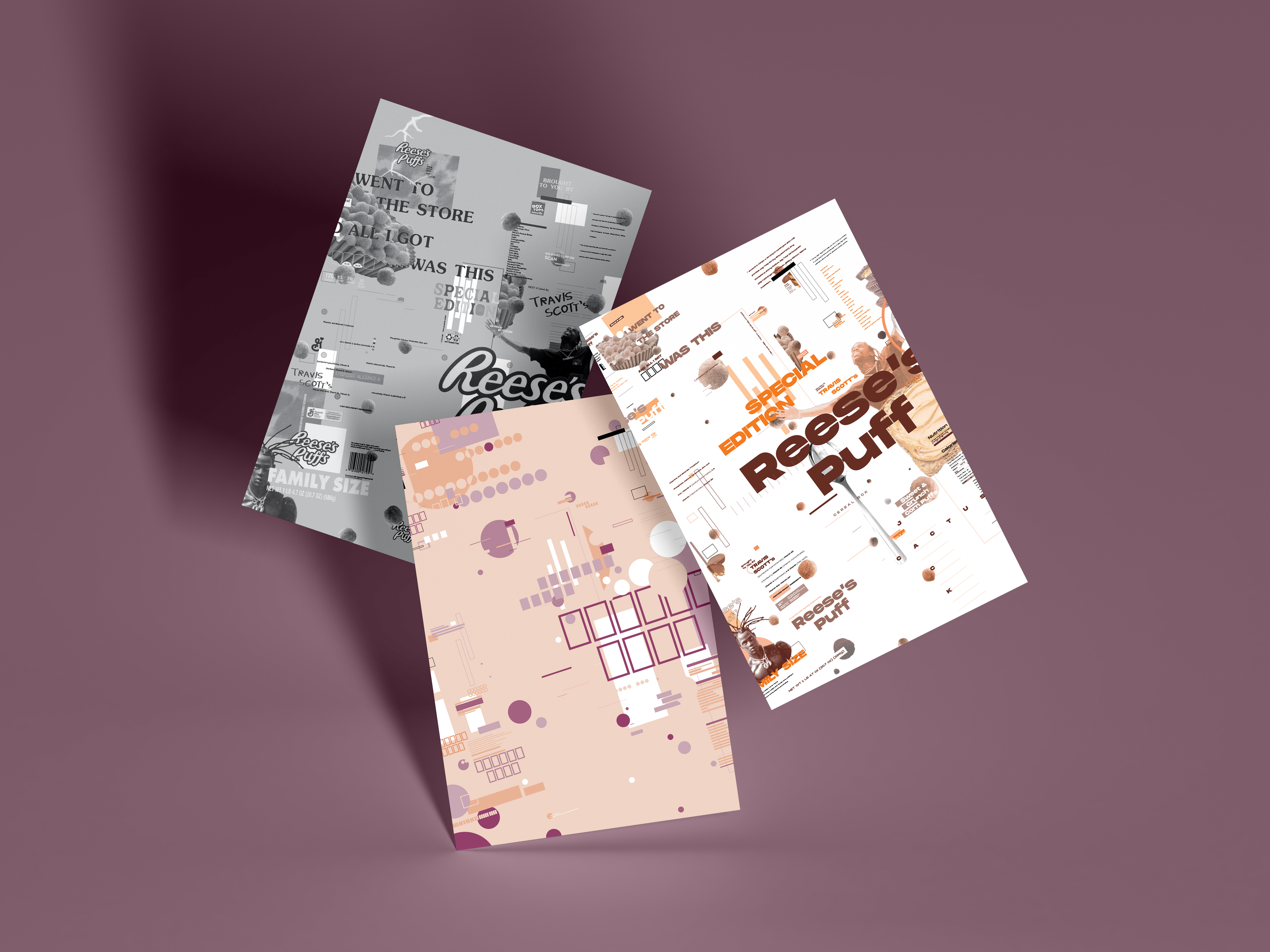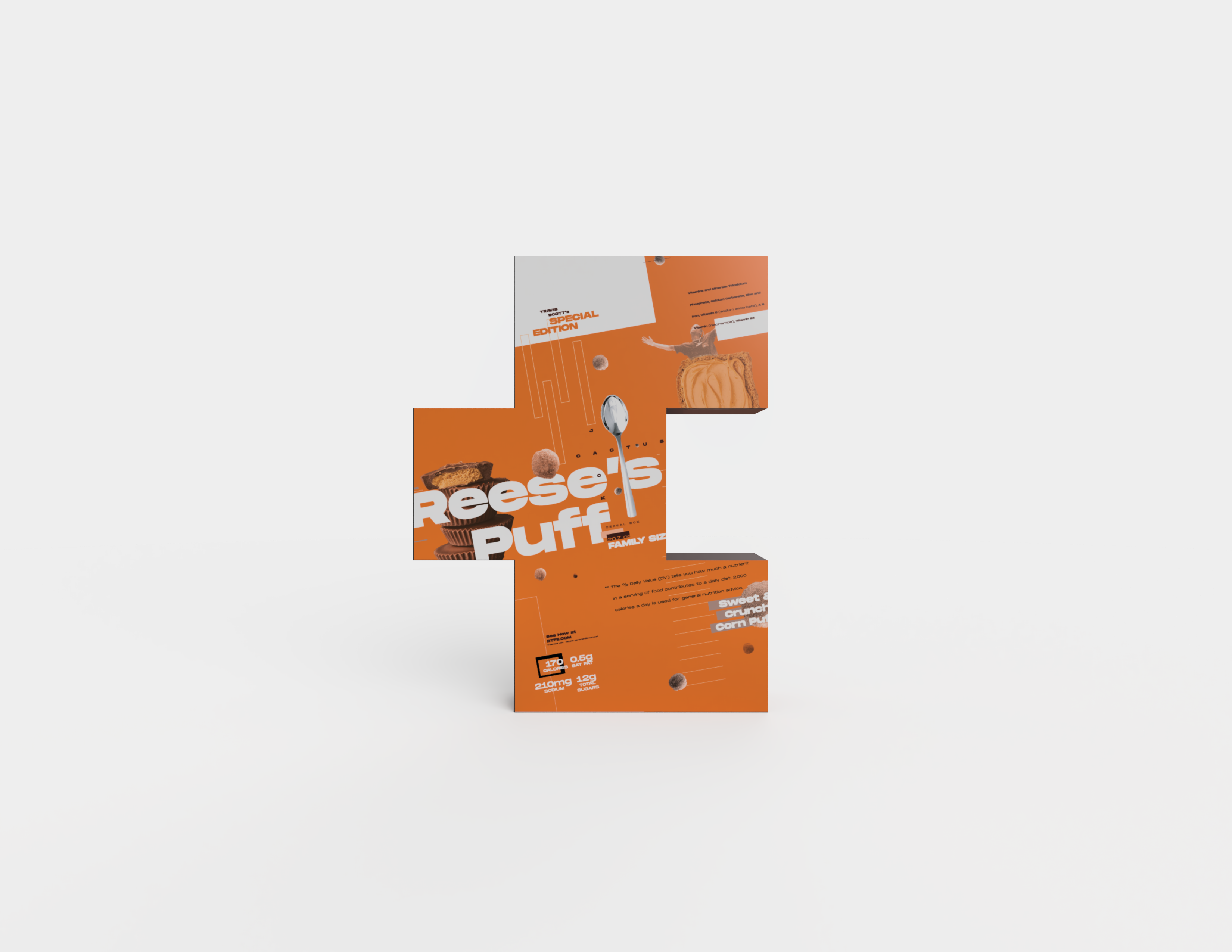
Reese’s Puffs Cereal Box Deconstruction
︎︎︎Fundamentals
Fall 2020
︎︎︎Fundamentals
Understanding what makes a composition work is a fundamental for designers. One must know how to properly use space, when to keep elements organized, and when to break some common rules. Some compositions are simple and open with very few things to work with, while others are complex and need more thought.
A cereal box is a great example of a composition that is cluttered with many different elements that need to be thoughtfully placed.Fall 2020
Project Overview
︎︎︎Break down the elements on a cereal box and create several new compositions using and altering everything seen on the original box.
︎︎︎Break down the elements on a cereal box and create several new compositions using and altering everything seen on the original box.
Areas of Focus
︎︎︎Composition
︎︎︎Color
︎︎︎Fundamentals
︎︎︎Composition
︎︎︎Color
︎︎︎Fundamentals
Programs
︎︎︎Photoshop
︎︎︎Illustrator
︎︎︎Photoshop
︎︎︎Illustrator

Breakdown
︎︎︎For this exercise, I chose to use a Special Edition box of Reese’s Puffs that musician Travis Scott promoted back in 2019. This box has a different set of elements compared to a traditional box of Reese’s Puffs, so the intention was to really use those parts up to make a unique composition.
︎︎︎For this exercise, I chose to use a Special Edition box of Reese’s Puffs that musician Travis Scott promoted back in 2019. This box has a different set of elements compared to a traditional box of Reese’s Puffs, so the intention was to really use those parts up to make a unique composition.

Composition 1: Black & White
︎︎︎This first composition uses the elements scanned directly off of the box and translated to gray scale. Scale, shape, and any other visual elements were not allowed to be altered at this point. This allows for emphasis on contrast of the given elements.
This initial phase was simple to understand, however once all the pieces were laid out, it became a much more difficult project. Understanding the flow of a composition and what works within negative spaces was very important during this first step.
︎︎︎This first composition uses the elements scanned directly off of the box and translated to gray scale. Scale, shape, and any other visual elements were not allowed to be altered at this point. This allows for emphasis on contrast of the given elements.
This initial phase was simple to understand, however once all the pieces were laid out, it became a much more difficult project. Understanding the flow of a composition and what works within negative spaces was very important during this first step.


Composition 2: Color & Shapes
︎︎︎For the second composition, the previous elements were replaced with abstracted forms and two colors and their shades and tones were introduced. This part of the exercise, flexes the design capability to maintain a sense of hierarchy with abstract shapes and colors. Scale of the abstract objects are meant to be close to accurate of the first composition.
This next step in the process was probably the easiest. The translation of the original composition to these abstract objects was fairly simple to do. The main focus of the process was to understand that the scale and contrast of elements should stay consistent to maintain a similar composition as before. Following that, adding color helps with the need for contrast.
︎︎︎For the second composition, the previous elements were replaced with abstracted forms and two colors and their shades and tones were introduced. This part of the exercise, flexes the design capability to maintain a sense of hierarchy with abstract shapes and colors. Scale of the abstract objects are meant to be close to accurate of the first composition.
This next step in the process was probably the easiest. The translation of the original composition to these abstract objects was fairly simple to do. The main focus of the process was to understand that the scale and contrast of elements should stay consistent to maintain a similar composition as before. Following that, adding color helps with the need for contrast.
Composition 3: Replace
︎︎︎For the third composition, the abstract elements are replaced again, using either the same elements from the first or pictures of elements that are similar. For example, the original box did not have a stack of Reese’s Pieces, however since the object is related, it was allowed in to compliment the overall piece. This composition also allowed for alterations with font, scale of objects, as well as changes in patterns.
This thrid part of the process allowed for much more creativity. Choosing what elements are to be brought back or altered, changing the overall font, and manipulating the scale all contributes to give the composition more life.
︎︎︎For the third composition, the abstract elements are replaced again, using either the same elements from the first or pictures of elements that are similar. For example, the original box did not have a stack of Reese’s Pieces, however since the object is related, it was allowed in to compliment the overall piece. This composition also allowed for alterations with font, scale of objects, as well as changes in patterns.
This thrid part of the process allowed for much more creativity. Choosing what elements are to be brought back or altered, changing the overall font, and manipulating the scale all contributes to give the composition more life.



Composition 4: 3D Modeling
︎︎︎For the final composition, the previous composition and it’s elements are placed on a redesigned cereal box. The box does not need to be functional, however it should compliment some of the elements introduced in the previous step. Here, the box imitates the stack of Reese’s Pieces while also giving more panels for the elements to be displayed on.
The final step in this exercise tested all the skills that were challenged in the first three. The first step, taking elements and arranging them as is. The second, maintaining a hierarchy by using scale and contrast. Lastly, the third by being creative with all the previous elements. This final step rounds out and captures what it takes to make a good composition even in a nonpractical object.
︎︎︎For the final composition, the previous composition and it’s elements are placed on a redesigned cereal box. The box does not need to be functional, however it should compliment some of the elements introduced in the previous step. Here, the box imitates the stack of Reese’s Pieces while also giving more panels for the elements to be displayed on.
The final step in this exercise tested all the skills that were challenged in the first three. The first step, taking elements and arranging them as is. The second, maintaining a hierarchy by using scale and contrast. Lastly, the third by being creative with all the previous elements. This final step rounds out and captures what it takes to make a good composition even in a nonpractical object.

